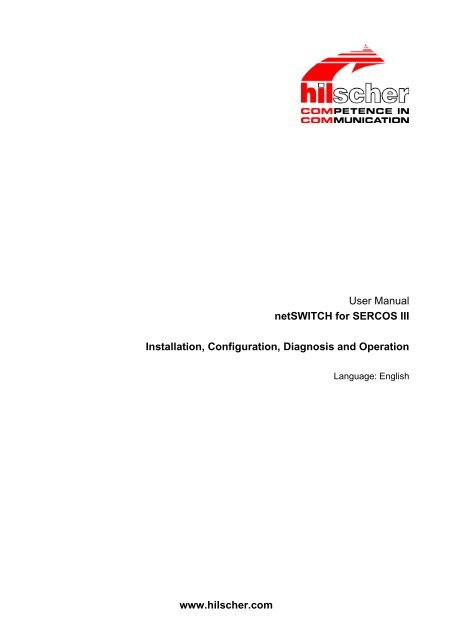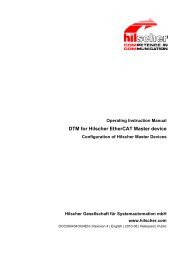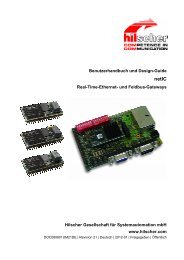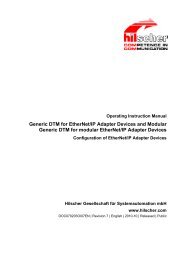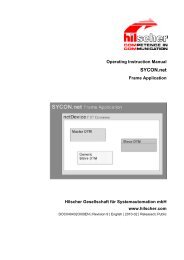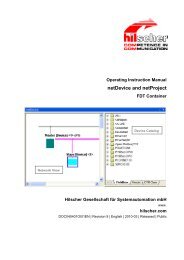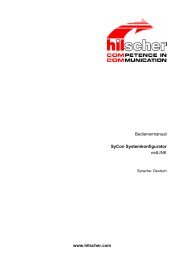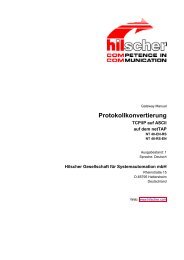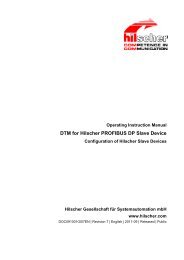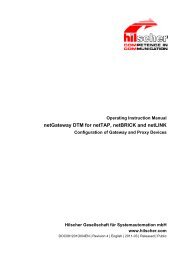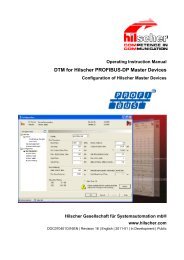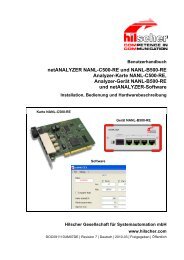netSWITCH SERCOS III - Hilscher
netSWITCH SERCOS III - Hilscher
netSWITCH SERCOS III - Hilscher
Create successful ePaper yourself
Turn your PDF publications into a flip-book with our unique Google optimized e-Paper software.
User Manual<br />
<strong>netSWITCH</strong> for <strong>SERCOS</strong> <strong>III</strong><br />
Installation, Configuration, Diagnosis and Operation<br />
Language: English<br />
www.hilscher.com
<strong>netSWITCH</strong> <strong>SERCOS</strong> <strong>III</strong> Table of Contents • 2<br />
Table of Contents<br />
1 INTRODUCTION.........................................................................................................4<br />
1.1 About the User Manual ...............................................................................................4<br />
1.1.1 List of Revisions ...................................................................................................4<br />
1.1.2 Reference on Hardware .......................................................................................4<br />
1.1.3 Reference on Firmware........................................................................................4<br />
1.1.4 Conventions in this Manual ..................................................................................5<br />
1.2 Contents of the Product CD........................................................................................6<br />
1.2.1 Directory Structure of the CD ...............................................................................6<br />
1.3 Legal Notes.................................................................................................................7<br />
1.3.1 Copyright ..............................................................................................................7<br />
1.3.2 Important Notes....................................................................................................7<br />
1.3.3 Exclusion of Liability .............................................................................................8<br />
1.3.4 Warranty ...............................................................................................................8<br />
1.3.5 Export Regulations ...............................................................................................9<br />
1.3.6 Registered Trademarks........................................................................................9<br />
2 SAFETY ....................................................................................................................10<br />
2.1 Intended Use ............................................................................................................10<br />
2.2 Personnel Qualification.............................................................................................10<br />
2.3 Labeling of Safety Instructions..................................................................................10<br />
2.4 Safety Instructions ....................................................................................................11<br />
3 OVERVIEW NETSWITCH <strong>SERCOS</strong> <strong>III</strong>.....................................................................12<br />
3.1 Description................................................................................................................12<br />
3.2 Sample Application ...................................................................................................13<br />
3.3 Requirements ...........................................................................................................14<br />
3.4 Illustrations <strong>netSWITCH</strong> <strong>SERCOS</strong> <strong>III</strong> Devices .........................................................14<br />
3.4.1 <strong>netSWITCH</strong> <strong>SERCOS</strong> <strong>III</strong> and one Standard Ethernet Port................................14<br />
4 CONNECTORS.........................................................................................................16<br />
4.1 Power Supply............................................................................................................16<br />
4.2 Communication.........................................................................................................17<br />
4.2.1 Ethernet ..............................................................................................................17<br />
4.2.2 Mini USB Connector (5 Pin) ...............................................................................18<br />
5 LED ...........................................................................................................................19<br />
5.1 <strong>netSWITCH</strong> <strong>SERCOS</strong> <strong>III</strong> and one Ethernet Port ......................................................19<br />
6 STARTING UP NETSWITCH <strong>SERCOS</strong> <strong>III</strong>................................................................20<br />
6.1 Installation.................................................................................................................20<br />
6.2 Unistalling Device .....................................................................................................20<br />
<strong>Hilscher</strong> Gesellschaft für Systemautomation mbH – Rheinstr. 15 – D 65795 Hattersheim<br />
Edition 4 – User manual:<strong>netSWITCH</strong> <strong>SERCOS</strong> <strong>III</strong>#EN – 2008/12
<strong>netSWITCH</strong> <strong>SERCOS</strong> <strong>III</strong> Table of Contents • 3<br />
6.3 Installing MMC Card .................................................................................................21<br />
6.4 Set Device back to Factory Settings.........................................................................21<br />
6.5 Access about Web Browser by NetBIOS Protocol ...................................................22<br />
6.6 Access about Web Browser using IP-Address .........................................................22<br />
6.6.1 Obtaining IP-Address from DHCP Server ..........................................................22<br />
6.6.2 Specify IP-Address via Web Browser.................................................................23<br />
6.7 Configuring Timing parameters ................................................................................24<br />
6.7.1 Configuring Timing Parameters automatically ...................................................24<br />
6.7.2 Configuring Timing Parameters manually ..........................................................25<br />
7 WEB PAGES FOR CONFIGURATION AND DIAGNOSIS........................................28<br />
7.1 Starting Web Pages <strong>netSWITCH</strong> <strong>SERCOS</strong> <strong>III</strong>..........................................................28<br />
7.2 “Status and Diagnosis” Page ....................................................................................29<br />
7.2.1 Connection .........................................................................................................30<br />
7.2.2 Parameters .........................................................................................................30<br />
7.2.3 Status <strong>SERCOS</strong> <strong>III</strong> side .....................................................................................31<br />
7.2.4 Status NRT Ethernet side...................................................................................32<br />
7.3 “Configuration Network Settings” Page ....................................................................33<br />
7.4 “Resetting to Factory Settings” Page........................................................................35<br />
8 TROUBLESHOOTING ..............................................................................................36<br />
9 TECHNICAL DATA ...................................................................................................37<br />
10 LISTS ........................................................................................................................38<br />
10.1 List of Figures ...........................................................................................................38<br />
10.2 List of Tables ............................................................................................................39<br />
10.3 References ...............................................................................................................39<br />
11 GLOSSARY...............................................................................................................40<br />
12 CONTACTS...............................................................................................................41<br />
<strong>Hilscher</strong> Gesellschaft für Systemautomation mbH – Rheinstr. 15 – D 65795 Hattersheim<br />
Edition 4 – Usermanual:<strong>netSWITCH</strong> <strong>SERCOS</strong> <strong>III</strong>#EN – 2008/12
<strong>netSWITCH</strong> <strong>SERCOS</strong> <strong>III</strong> Introduction • 4<br />
1 Introduction<br />
1.1 About the User Manual<br />
1.1.1 List of Revisions<br />
This User Manual contains a short description about installation,<br />
configuration, diagnosis and operation of the <strong>netSWITCH</strong> <strong>SERCOS</strong> <strong>III</strong><br />
devices.<br />
Index Date Hard / Software Chapter Revisions<br />
1 25.07.07 Firmware Version<br />
V0.96.0 Build 100<br />
all<br />
2 19-11.07 ibidem all<br />
1<br />
3<br />
3.1<br />
17.09.08 Firmware Version:<br />
V1.0.1.x<br />
Hardware Version:<br />
Rev3<br />
4 10.12.08 Firmware Version:<br />
V1.0.4.x<br />
Hardware Version:<br />
Rev3/4<br />
3.1<br />
3.3<br />
3.4.1<br />
4.2.1<br />
5.1<br />
6<br />
7<br />
8<br />
9<br />
6.4<br />
5.1<br />
created<br />
Device description actualized,<br />
Chapter Introduction actualized<br />
Section ‚Description’ completed and actualized,<br />
Section ‚Requirements’ actualized,<br />
Device drawing updated,<br />
Section ‚Ethernet’ actualized,<br />
Section ‚<strong>netSWITCH</strong> <strong>SERCOS</strong> <strong>III</strong> and one Ethernet Port’<br />
completed and actualized, Table 13 updated<br />
Chapter ‚Starting up <strong>netSWITCH</strong> <strong>SERCOS</strong> <strong>III</strong>’ completed and<br />
actualized,<br />
Chapter ‚Web Pages for Configuration and Diagnosis’ completed<br />
and actualized,<br />
Chapter ‚Trouble Shooting’ actualized,<br />
Chapter ‚Technical Data’ actualized.<br />
Section ‚ 6.4 Set Device back to Factory Settings’ added<br />
Table with LED description updadated, LED description changed<br />
Table 1: List of Revisions<br />
1.1.2 Reference on Hardware<br />
Device Type Product Device<br />
NS-S3-1NRT <strong>netSWITCH</strong> <strong>SERCOS</strong> <strong>III</strong> and one Ethernet Port Revision 3, 4<br />
Table 2: Reference on Hardware<br />
1.1.3 Reference on Firmware<br />
Firmware Protocol Version<br />
netx.rom <strong>netSWITCH</strong> <strong>SERCOS</strong> <strong>III</strong> V1.0.4.x<br />
Table 3: Reference on Firmware<br />
<strong>Hilscher</strong> Gesellschaft für Systemautomation mbH – Rheinstr. 15 – D 65795 Hattersheim<br />
Edition 4 – Usermanual:<strong>netSWITCH</strong> <strong>SERCOS</strong> <strong>III</strong>#EN – 2008/12
<strong>netSWITCH</strong> <strong>SERCOS</strong> <strong>III</strong> Introduction • 5<br />
1.1.4 Conventions in this Manual<br />
Operating Instructions, a result of an operation step or notes are marked as<br />
follows:<br />
Operating Instructions:<br />
‣ <br />
or<br />
1. <br />
2. <br />
Results:<br />
<br />
Notes:<br />
Note: <br />
<strong>Hilscher</strong> Gesellschaft für Systemautomation mbH – Rheinstr. 15 – D 65795 Hattersheim<br />
Edition 4 – Usermanual:<strong>netSWITCH</strong> <strong>SERCOS</strong> <strong>III</strong>#EN – 2008/12
<strong>netSWITCH</strong> <strong>SERCOS</strong> <strong>III</strong> Introduction • 6<br />
1.2 Contents of the Product CD<br />
The product CD contains:<br />
• Documentation: User Manual (this document)<br />
• Loadable Firmware<br />
1.2.1 Directory Structure of the CD<br />
All manuals on this CD are delivered in the Adobe Acrobat ® Reader format<br />
(PDF).<br />
Directory Name<br />
Documentation<br />
Firmware<br />
Description<br />
Documentation in the Acrobat ® Reader Format (PDF)<br />
Loadable Firmware<br />
Table 4: Directory Structure of the CD<br />
<strong>Hilscher</strong> Gesellschaft für Systemautomation mbH – Rheinstr. 15 – D 65795 Hattersheim<br />
Edition 4 – Usermanual:<strong>netSWITCH</strong> <strong>SERCOS</strong> <strong>III</strong>#EN – 2008/12
<strong>netSWITCH</strong> <strong>SERCOS</strong> <strong>III</strong> Introduction • 7<br />
1.3 Legal Notes<br />
1.3.1 Copyright<br />
1.3.2 Important Notes<br />
© 2008 <strong>Hilscher</strong> Gesellschaft für Systemautomation mbH<br />
All rights reserved.<br />
The images, photographs and texts in the accompanying material (user<br />
manual, accompanying texts, documentation, etc.) are protected by<br />
German and international copyright law as well as international trade and<br />
protection provisions. You are not authorized to duplicate these in whole or<br />
in part using technical or mechanical methods (printing, photocopying or<br />
other methods), to manipulate or transfer using electronic systems without<br />
prior written consent. You are not permitted to make changes to copyright<br />
notices, markings, trademarks or ownership declarations. The included<br />
diagrams do not take the patent situation into account. The company<br />
names and product descriptions included in this document may be<br />
trademarks or brands of the respective owners and may be trademarked or<br />
patented. Any form of further use requires the explicit consent of the<br />
respective rights owner.<br />
The user manual, accompanying texts and the documentation were created<br />
for the use of the products by qualified experts, however, errors cannot be<br />
ruled out. For this reason, no guarantee can be made and neither juristic<br />
responsibility for erroneous information nor any liability can be assumed.<br />
Descriptions, accompanying texts and documentation included in the user<br />
manual do not present a guarantee nor any information about proper use<br />
as stipulated in the contract or a warranted feature. It cannot be ruled out<br />
that the user manual, the accompanying texts and the documentation do<br />
not correspond exactly to the described features, standards or other data of<br />
the delivered product. No warranty or guarantee regarding the correctness<br />
or accuracy of the information is assumed.<br />
We reserve the right to change our products and their specification as well<br />
as related user manuals, accompanying texts and documentation at all<br />
times and without advance notice, without obligation to report the change.<br />
Changes will be included in future manuals and do not constitute any<br />
obligations. There is no entitlement to revisions of delivered documents.<br />
The manual delivered with the product applies.<br />
<strong>Hilscher</strong> Gesellschaft für Systemautomation mbH is not liable under any<br />
circumstances for direct, indirect, incidental or follow-on damage or loss of<br />
earnings resulting from the use of the information contained in this<br />
publication.<br />
<strong>Hilscher</strong> Gesellschaft für Systemautomation mbH – Rheinstr. 15 – D 65795 Hattersheim<br />
Edition 4 – Usermanual:<strong>netSWITCH</strong> <strong>SERCOS</strong> <strong>III</strong>#EN – 2008/12
<strong>netSWITCH</strong> <strong>SERCOS</strong> <strong>III</strong> Introduction • 8<br />
1.3.3 Exclusion of Liability<br />
1.3.4 Warranty<br />
The software was produced and tested with utmost care by <strong>Hilscher</strong><br />
Gesellschaft für Systemautomation mbH and is made available as is. No<br />
warranty can be assumed for the performance and flawlessness of the<br />
software for all usage conditions and cases and for the results produced<br />
when utilized by the user. Liability for any damages that may result from the<br />
use of the hardware or software or related documents, is limited to cases of<br />
intent or grossly negligent violation of significant contractual obligations.<br />
Indemnity claims for the violation of significant contractual obligations are<br />
limited to damages that are foreseeable and typical for this type of contract.<br />
It is strictly prohibited to use the software in the following areas:<br />
• for military purposes or in weapon systems;<br />
• for the design, construction, maintenance or operation of nuclear<br />
facilities;<br />
• in air traffic control systems, air traffic or air traffic communication<br />
systems;<br />
• in life support systems;<br />
• in systems in which failures in the software could lead to personal injury<br />
or injuries leading to death.<br />
We inform you that the software was not developed for use in dangerous<br />
environments requiring fail-proof control mechanisms. Use of the software<br />
in such an environment occurs at your own risk. No liability is assumed for<br />
damages or losses due to unauthorized use.<br />
Although the hardware and software was developed with utmost care and<br />
tested intensively, <strong>Hilscher</strong> Gesellschaft für Systemautomation mbH does<br />
not guarantee its suitability for any purpose not confirmed in writing. It<br />
cannot be guaranteed that the hardware and software will meet your<br />
requirements, that the use of the software operates without interruption and<br />
that the software is free of errors. No guarantee is made regarding<br />
infringements, violations of patents, rights of ownership or the freedom from<br />
interference by third parties. No additional guarantees or assurances are<br />
made regarding marketability, freedom of defect of title, integration or<br />
usability for certain purposes unless they are required in accordance with<br />
the law and cannot be limited. Warranty claims are limited to the right to<br />
claim rectification.<br />
<strong>Hilscher</strong> Gesellschaft für Systemautomation mbH – Rheinstr. 15 – D 65795 Hattersheim<br />
Edition 4 – Usermanual:<strong>netSWITCH</strong> <strong>SERCOS</strong> <strong>III</strong>#EN – 2008/12
<strong>netSWITCH</strong> <strong>SERCOS</strong> <strong>III</strong> Introduction • 9<br />
1.3.5 Export Regulations<br />
The delivered product (including the technical data) is subject to export or<br />
import laws as well as the associated regulations of different counters, in<br />
particular those of Germany and the USA. The software may not be<br />
exported to countries where this is prohibited by the United States Export<br />
Administration Act and its additional provisions. You are obligated to<br />
comply with the regulations at your personal responsibility. We wish to<br />
inform you that you may require permission from state authorities to export,<br />
re-export or import the product.<br />
1.3.6 Registered Trademarks<br />
Windows ® 2000 / Windows ® XP are registered trademarks of Microsoft<br />
Corporation.<br />
Adobe-Acrobat ® is an registered trademark of the Adobe Systems<br />
Incorporated.<br />
<strong>Hilscher</strong> Gesellschaft für Systemautomation mbH – Rheinstr. 15 – D 65795 Hattersheim<br />
Edition 4 – Usermanual:<strong>netSWITCH</strong> <strong>SERCOS</strong> <strong>III</strong>#EN – 2008/12
<strong>netSWITCH</strong> <strong>SERCOS</strong> <strong>III</strong> Safety • 10<br />
2 Safety<br />
2.1 Intended Use<br />
2.2 Personnel Qualification<br />
The <strong>netSWITCH</strong> <strong>SERCOS</strong> <strong>III</strong> devices described in this User Manual serve<br />
to couple <strong>SERCOS</strong> <strong>III</strong> network with standard Ethernet.<br />
The <strong>netSWITCH</strong> <strong>SERCOS</strong> <strong>III</strong> device must only be installed, configured and<br />
removed by qualified personnel.<br />
2.3 Labeling of Safety Instructions<br />
The safety instructions are pinpointed particularly. The instructions are<br />
highlighted with a specific safety symbol, a warning triangle and a signal<br />
word according to the degree of endangerment. Inside the note the danger<br />
is exactly named. Instructions to a property damage message do not<br />
contain a warning triangle.<br />
Symbol Sort of Warning or Principle<br />
Safety symbol for the warning to personal injury<br />
Table 5: Safety Symbols and Sort of Warning or Principle<br />
2.3.1.1 Signal Words<br />
Signal Word<br />
DANGER<br />
WARNING<br />
CAUTION<br />
Note<br />
Meaning<br />
Table 6: Signal Words<br />
indicates a direct hazard with high risk, which will have as consequence<br />
death or grievous bodily harm if it isn't avoided.<br />
The use of this signal word shall be restricted to extremely hazard.<br />
Remark: The signal word may not be used in case of danger of pure<br />
property damages.<br />
indicates a possible hazard with medium risk, which will have as<br />
consequence death or (grievous) bodily harm if it isn't avoided.<br />
Remark: The signal word may not be used in case of danger of pure<br />
property damages.<br />
indicates a minor hazard with medium risk, which could have as<br />
consequence simple battery if it isn't avoided.<br />
Indicates an important note in the manual.<br />
<strong>Hilscher</strong> Gesellschaft für Systemautomation mbH – Rheinstr. 15 – D 65795 Hattersheim<br />
Edition 4 – Usermanual:<strong>netSWITCH</strong> <strong>SERCOS</strong> <strong>III</strong>#EN – 2008/12
<strong>netSWITCH</strong> <strong>SERCOS</strong> <strong>III</strong> Safety • 11<br />
2.3.1.2 Signal Words USA<br />
Signal Word<br />
DANGER<br />
WARNING<br />
CAUTION<br />
NOTICE<br />
Note<br />
2.4 Safety Instructions<br />
Meaning<br />
Indicates a Hazardous Situation Which, if not Avoided, will Result in Death<br />
or Serious Injury.<br />
Indicates a Hazardous Situation Which, if not Avoided, could Result in<br />
Death or Serious Injury.<br />
Indicates a Hazardous Situation Which, if not Avoided, may Result in<br />
Minor or Moderate Injury.<br />
Indicates a Property Damage Message.<br />
Indicates an Important Note in the Manual.<br />
Table 7: Signal Words according to ANSI<br />
This manual contains instructions which must be observed to ensure your<br />
own personal safety and to avoid damage to devices.<br />
<strong>Hilscher</strong> Gesellschaft für Systemautomation mbH – Rheinstr. 15 – D 65795 Hattersheim<br />
Edition 4 – Usermanual:<strong>netSWITCH</strong> <strong>SERCOS</strong> <strong>III</strong>#EN – 2008/12
<strong>netSWITCH</strong> <strong>SERCOS</strong> <strong>III</strong> Overview <strong>netSWITCH</strong> <strong>SERCOS</strong> <strong>III</strong> • 12<br />
3 Overview <strong>netSWITCH</strong> <strong>SERCOS</strong> <strong>III</strong><br />
3.1 Description<br />
The <strong>netSWITCH</strong> <strong>SERCOS</strong> <strong>III</strong> devices couple a <strong>SERCOS</strong> <strong>III</strong> network with a<br />
standard Ethernet network.<br />
The Real-Time Ethernet system <strong>SERCOS</strong> <strong>III</strong> provides a deterministic jitterfree<br />
data transmission for controlling and synchronizing drives. Parallel to<br />
this and based on a time-slot basis, standard Ethernet telegrams 1 can be<br />
transmitted via a NRT (None-Real-Time) channel. These NRT telegrams<br />
must be buffered for retransmission on a standard Ethernet network. The<br />
<strong>netSWITCH</strong> <strong>SERCOS</strong> <strong>III</strong> provides this buffer connection between the<br />
synchronized <strong>SERCOS</strong> <strong>III</strong> network and standard Ethernet.<br />
The <strong>netSWITCH</strong> <strong>SERCOS</strong> <strong>III</strong> device provides two Real-Time Ethernet ports<br />
for <strong>SERCOS</strong> <strong>III</strong>. Furthermore a standard Ethernet port is available to<br />
connect a notebook or other standard Ethernet capable devices and to<br />
provide access to the internal Web server that is used for configuration.<br />
The device firmware is loaded and executed from the inserted MMC card.<br />
In the <strong>SERCOS</strong> <strong>III</strong> network, <strong>SERCOS</strong> <strong>III</strong> telegrams and standard Ethernet<br />
telegrams on the NRT channel are received by the <strong>netSWITCH</strong><br />
<strong>SERCOS</strong> <strong>III</strong>. The standard Ethernet telegrams of the NRT channel are<br />
forwarded by the <strong>netSWITCH</strong> <strong>SERCOS</strong> <strong>III</strong> to the standard Ethernet port<br />
(NRT-port) making these messages available to users outside the<br />
<strong>SERCOS</strong> <strong>III</strong> ring. Likewise standard Ethernet telegrams that are received<br />
by the <strong>netSWITCH</strong> <strong>SERCOS</strong> <strong>III</strong> at the standard Ethernet port (NRT-port)<br />
are inserted into the NRT channel of the <strong>SERCOS</strong> <strong>III</strong> network for delivery to<br />
<strong>SERCOS</strong> <strong>III</strong> components.<br />
The <strong>netSWITCH</strong> <strong>SERCOS</strong> <strong>III</strong> forwards the <strong>SERCOS</strong> <strong>III</strong> telegrams with a<br />
throughput of 600 ns. Non-<strong>SERCOS</strong> <strong>III</strong> Ethernet Frames are processed<br />
according to the Store-and-Forward principle.<br />
The <strong>SERCOS</strong> <strong>III</strong> norm specifies the start time t 6 and the final time t 7 for the<br />
time slot of the NRT channel in the communication phases CP0..2<br />
definitely. A <strong>SERCOS</strong> <strong>III</strong> master with the "NRT-plug support" functionality<br />
sends the time slot parameters of the <strong>SERCOS</strong> <strong>III</strong> NRT channel during start<br />
up for the communication phases CP3..4. The <strong>netSWITCH</strong> <strong>SERCOS</strong> <strong>III</strong><br />
device detects and adjusts the time slot for the <strong>SERCOS</strong> <strong>III</strong> NRT channel<br />
after that automatically. Thereby the <strong>netSWITCH</strong> <strong>SERCOS</strong> <strong>III</strong> can be<br />
operated without a previous manual configuration in the <strong>SERCOS</strong> <strong>III</strong><br />
network.<br />
If the <strong>SERCOS</strong> <strong>III</strong> master does not support the "NRT-plug support" function,<br />
the user has the option of using the integrated Web browser to configure<br />
the <strong>netSWITCH</strong> <strong>SERCOS</strong> <strong>III</strong> device start time t 6 and end time t 7 for the time<br />
slot of all communications phases of the <strong>SERCOS</strong> <strong>III</strong> NRT channel<br />
manually and to save this data remanently to the device.<br />
For the control of the communication and device state LED are integrated<br />
at the <strong>netSWITCH</strong> <strong>SERCOS</strong> <strong>III</strong>. Using the internal Web browser further<br />
status and diagnosis information can be read from the <strong>netSWITCH</strong><br />
<strong>SERCOS</strong> <strong>III</strong> device.<br />
1 According to IEEE 802.3<br />
<strong>Hilscher</strong> Gesellschaft für Systemautomation mbH – Rheinstr. 15 – D 65795 Hattersheim<br />
Edition 4 – Usermanual:<strong>netSWITCH</strong> <strong>SERCOS</strong> <strong>III</strong>#EN – 2008/12
<strong>netSWITCH</strong> <strong>SERCOS</strong> <strong>III</strong> Overview <strong>netSWITCH</strong> <strong>SERCOS</strong> <strong>III</strong> • 13<br />
3.2 Sample Application<br />
The following figure shows a sample application for the <strong>netSWITCH</strong><br />
<strong>SERCOS</strong> <strong>III</strong> device.<br />
Figure 1: Sample Application<br />
<strong>Hilscher</strong> Gesellschaft für Systemautomation mbH – Rheinstr. 15 – D 65795 Hattersheim<br />
Edition 4 – Usermanual:<strong>netSWITCH</strong> <strong>SERCOS</strong> <strong>III</strong>#EN – 2008/12
<strong>netSWITCH</strong> <strong>SERCOS</strong> <strong>III</strong> Overview <strong>netSWITCH</strong> <strong>SERCOS</strong> <strong>III</strong> • 14<br />
3.3 Requirements<br />
• DC power supply with 24 V (18 - 30 V) output voltage<br />
• <strong>SERCOS</strong> <strong>III</strong> Communication Master and at least one <strong>SERCOS</strong> <strong>III</strong> Slave<br />
• Ethernet Cable<br />
• PC with Ethernet connector for configuration and diagnosis<br />
• Java capable Web browser<br />
(Java Runtime Environment (jre), Version 1.5 or higher)<br />
3.4 Illustrations <strong>netSWITCH</strong> <strong>SERCOS</strong> <strong>III</strong> Devices<br />
Device type<br />
NS-S3-1NRT<br />
Article<br />
<strong>netSWITCH</strong> <strong>SERCOS</strong> <strong>III</strong> and one Ethernet port<br />
Table 8: <strong>netSWITCH</strong> <strong>SERCOS</strong> <strong>III</strong> devices<br />
3.4.1 <strong>netSWITCH</strong> <strong>SERCOS</strong> <strong>III</strong> and one Standard Ethernet Port<br />
The following figure shows the <strong>netSWITCH</strong> device in front view.<br />
Figure 2: <strong>netSWITCH</strong> <strong>SERCOS</strong> <strong>III</strong> and one Standard Ethernet Port – Front view<br />
<strong>Hilscher</strong> Gesellschaft für Systemautomation mbH – Rheinstr. 15 – D 65795 Hattersheim<br />
Edition 4 – Usermanual:<strong>netSWITCH</strong> <strong>SERCOS</strong> <strong>III</strong>#EN – 2008/12
<strong>netSWITCH</strong> <strong>SERCOS</strong> <strong>III</strong> Overview <strong>netSWITCH</strong> <strong>SERCOS</strong> <strong>III</strong> • 15<br />
Below the cover DIAG is a Mini USB connector available. This connector is<br />
without function.<br />
Figure 3: <strong>netSWITCH</strong> <strong>SERCOS</strong> <strong>III</strong> and one Standard Ethernet Port – DIAG<br />
The following figure shows the <strong>netSWITCH</strong> device in side view (view from<br />
the right side).<br />
Figure 4: <strong>netSWITCH</strong> <strong>SERCOS</strong> <strong>III</strong> and one Standard Ethernet Port – Side view<br />
<strong>Hilscher</strong> Gesellschaft für Systemautomation mbH – Rheinstr. 15 – D 65795 Hattersheim<br />
Edition 4 – Usermanual:<strong>netSWITCH</strong> <strong>SERCOS</strong> <strong>III</strong>#EN – 2008/12
<strong>netSWITCH</strong> <strong>SERCOS</strong> <strong>III</strong> Connectors • 16<br />
4 Connectors<br />
4.1 Power Supply<br />
The <strong>netSWITCH</strong> <strong>SERCOS</strong> <strong>III</strong> device can be operated by a DC power<br />
supply from 24V (18V – 30V).<br />
‣ Plug the DC power supply into the power jack X1 located at the top side<br />
of the device.<br />
Pin<br />
Description<br />
1 Ground<br />
2 24V<br />
(18 - 30 V DC)<br />
Table 9: Power Supply, X1<br />
Figure 5: Power Supply, X1<br />
<strong>Hilscher</strong> Gesellschaft für Systemautomation mbH – Rheinstr. 15 – D 65795 Hattersheim<br />
Edition 4 – Usermanual:<strong>netSWITCH</strong> <strong>SERCOS</strong> <strong>III</strong>#EN – 2008/12
<strong>netSWITCH</strong> <strong>SERCOS</strong> <strong>III</strong> Connectors • 17<br />
4.2 Communication<br />
4.2.1 Ethernet<br />
The <strong>netSWITCH</strong> <strong>SERCOS</strong> <strong>III</strong> device provides two <strong>SERCOS</strong> <strong>III</strong> ports and<br />
one standard Ethernet port for the connection of a notebook or other<br />
Ethernet capable devices.<br />
For the Ethernet interface use RJ45 plugs and twisted pair cable of<br />
category 5 (CAT5) which consists of 4 twisted cores and is usable for a<br />
transmission rate of 100 MBit/s (CAT5).<br />
4.2.1.1 Ethernet Pinning at the RJ45 female Connector<br />
Note: The <strong>SERCOS</strong> <strong>III</strong> RT-ports and the standard Ethernet port support<br />
the Auto Crossover function. Due to this fact RX and TX can be<br />
switched.<br />
The following figure shows the RJ45 standard pinning.<br />
Figure 6: Ethernet Pinning at the RJ45 female Connector<br />
Pin Signal Meaning<br />
1 TX+ Transmit Data +<br />
2 TX– Transmit Data –<br />
3 RX+ Receive Data +<br />
4 Term 1 Connected to each other and<br />
5 Term 1<br />
terminated to PE through RC circuit*<br />
6 RX– Receive Data –<br />
7 Term 2 Connected to each other and<br />
8 Term 2<br />
terminated to PE through RC circuit*<br />
* Bob Smith Termination<br />
Table 10: Ethernet Pinning at the RJ45 female Connector<br />
<strong>Hilscher</strong> Gesellschaft für Systemautomation mbH – Rheinstr. 15 – D 65795 Hattersheim<br />
Edition 4 – Usermanual:<strong>netSWITCH</strong> <strong>SERCOS</strong> <strong>III</strong>#EN – 2008/12
<strong>netSWITCH</strong> <strong>SERCOS</strong> <strong>III</strong> Connectors • 18<br />
4.2.1.2 Ethernet Connection Data<br />
Medium<br />
2 x 2 Twisted-Pair cupric cable, CAT5 (100 MBit/s)<br />
Length of cable max. 100 m<br />
Transmission rate <strong>SERCOS</strong> <strong>III</strong> RT-port<br />
100 MBit/s<br />
full-duplex<br />
Standard Ethernet<br />
10 MBit/s / 100 MBit/s<br />
full-duplex/half-duplex<br />
Table 11: Ethernet Connection Data<br />
4.2.1.3 Use of Hubs and Switches<br />
The following table shows the use of hubs and switches by<br />
<strong>SERCOS</strong> <strong>III</strong> port:<br />
<strong>netSWITCH</strong> <strong>SERCOS</strong> <strong>III</strong> Port Hub Switch<br />
Standard Ethernet applicable applicable<br />
<strong>SERCOS</strong> <strong>III</strong> forbidden forbidden<br />
Table 12: Use of Hubs and Switches<br />
4.2.2 Mini USB Connector (5 Pin)<br />
(without function)<br />
Figure 7: Mini USB Connector (5 Pin)<br />
Pin Name Description<br />
1 USB_EXT USB Bus Power (+5V, supplied externally)<br />
2 D- Data -<br />
3 D+ Data +<br />
4 ID Not connected<br />
5 GND Ground<br />
Table 13: Pin out<br />
<strong>Hilscher</strong> Gesellschaft für Systemautomation mbH – Rheinstr. 15 – D 65795 Hattersheim<br />
Edition 4 – Usermanual:<strong>netSWITCH</strong> <strong>SERCOS</strong> <strong>III</strong>#EN – 2008/12
<strong>netSWITCH</strong> <strong>SERCOS</strong> <strong>III</strong> LED • 19<br />
5 LED<br />
For the control of the communication and device state the <strong>netSWITCH</strong><br />
<strong>SERCOS</strong> <strong>III</strong> is equipped with LED.<br />
5.1 <strong>netSWITCH</strong> <strong>SERCOS</strong> <strong>III</strong> and one Ethernet Port<br />
LED <strong>netSWITCH</strong> <strong>SERCOS</strong> <strong>III</strong> and one Ethernet Port (NS-S3-1NRT):<br />
Labeling (Color) Function Labeling (Color) Function<br />
SYS<br />
(yellow / green)<br />
APL<br />
STA0<br />
STA1<br />
RJ45<br />
CH0<br />
(X2)<br />
green<br />
yellow<br />
SYS RJ45 green LINK<br />
(X3)<br />
not used<br />
yellow ACT<br />
Status<br />
<strong>SERCOS</strong><br />
<strong>III</strong> RT-port<br />
(CH0)<br />
Status<br />
<strong>SERCOS</strong><br />
<strong>III</strong> RT-Port<br />
(CH1)<br />
LINK<br />
ACT<br />
RJ45 green LINK<br />
CH1<br />
(X2) yellow ACT<br />
Table 14: LED <strong>netSWITCH</strong> <strong>SERCOS</strong> <strong>III</strong> and one Ethernet Port<br />
LED Color State Meaning<br />
SYS<br />
green On Operating System running<br />
green Flashing cyclic at 5<br />
Hz<br />
yellow Flashing cyclic at 1<br />
Hz<br />
Devices indicates 'Reset to Factory Settings'<br />
Device indicates boot error.<br />
No firmware was found.<br />
yellow static Bootloader is waiting for booting procedure<br />
- Off Power supply for the device is missing or hardware defect<br />
STA0<br />
STA1<br />
green static <strong>SERCOS</strong> <strong>III</strong> RT-port is in communication phase CP4<br />
orange<br />
(red/green<br />
at the same<br />
time)<br />
red/green<br />
static<br />
cyclic changing<br />
between red and<br />
green<br />
<strong>SERCOS</strong> <strong>III</strong> RT-port is in communication phase CP0,<br />
CP1, CP2 or CP3<br />
<strong>SERCOS</strong> <strong>III</strong> RT-port is in NRT Modus<br />
LINK green On A connection to the Ethernet exists<br />
- Off The device has no connection to the Ethernet<br />
ACT yellow Flashing The device sends/receives Ethernet frames<br />
Table 15: LED <strong>netSWITCH</strong> <strong>SERCOS</strong> <strong>III</strong> and one Ethernet Port – Meaning of the States<br />
<strong>Hilscher</strong> Gesellschaft für Systemautomation mbH – Rheinstr. 15 – D 65795 Hattersheim<br />
Edition 4 – Usermanual:<strong>netSWITCH</strong> <strong>SERCOS</strong> <strong>III</strong>#EN – 2008/12
<strong>netSWITCH</strong> <strong>SERCOS</strong> <strong>III</strong> Starting up <strong>netSWITCH</strong> <strong>SERCOS</strong> <strong>III</strong> • 20<br />
6 Starting up <strong>netSWITCH</strong> <strong>SERCOS</strong> <strong>III</strong><br />
6.1 Installation<br />
How to proceed:<br />
1. Install the DIN rail for the <strong>netSWITCH</strong> <strong>SERCOS</strong> <strong>III</strong> at the designated<br />
mounting place.<br />
2. [A] Insert the <strong>netSWITCH</strong> <strong>SERCOS</strong> <strong>III</strong> with the upper side of the<br />
mounting plate into the DIN rail.<br />
3. [B] Then press the <strong>netSWITCH</strong> <strong>SERCOS</strong> <strong>III</strong> at its lower side towards<br />
the mounting plate until it engages at the DIN rail.<br />
6.2 Unistalling Device<br />
Figure 8: Mounting <strong>netSWITCH</strong> <strong>SERCOS</strong> <strong>III</strong><br />
4. Afterwards connect the 24 V power supply to the <strong>netSWITCH</strong><br />
<strong>SERCOS</strong> <strong>III</strong> device.<br />
The grounding of the <strong>netSWITCH</strong> <strong>SERCOS</strong> <strong>III</strong> is made by the earth<br />
terminal to the DIN rail at the back of the device.<br />
Tools:<br />
• Screwdriver<br />
How to proceed:<br />
1. Remove the power supply of the device.<br />
2. Remove the Ethernet cable.<br />
3. Remove the device from the DIN rail.<br />
‣ Apply the screw driver in the mounting link at the lower side of the<br />
device.<br />
‣ Open the interlock by use of the screwdriver.<br />
4. Remove device from DIN rail.<br />
<strong>Hilscher</strong> Gesellschaft für Systemautomation mbH – Rheinstr. 15 – D 65795 Hattersheim<br />
Edition 4 – Usermanual:<strong>netSWITCH</strong> <strong>SERCOS</strong> <strong>III</strong>#EN – 2008/12
<strong>netSWITCH</strong> <strong>SERCOS</strong> <strong>III</strong> Starting up <strong>netSWITCH</strong> <strong>SERCOS</strong> <strong>III</strong> • 21<br />
6.3 Installing MMC Card<br />
Requirements:<br />
• MMC card with the firmware for the <strong>netSWITCH</strong> <strong>SERCOS</strong> <strong>III</strong> (file name<br />
netX.rom)<br />
How to proceed:<br />
1. Disconnect power supply from the <strong>netSWITCH</strong> <strong>SERCOS</strong> <strong>III</strong> device.<br />
2. Slot the MMC card into the SD / MMC card connector until it engages.<br />
3. Connect the 24-V power supply to the device.<br />
The device loads the firmware and is in operation state then.<br />
6.4 Set Device back to Factory Settings<br />
How to proceed:<br />
1. Disconnect power supply from the <strong>netSWITCH</strong> <strong>SERCOS</strong> <strong>III</strong> device.<br />
2. Push the switch to position RES (downwards) and hold it in this<br />
position.<br />
3. Connect the 24-V power supply to the device.<br />
4. Hold the switch for 3 seconds until the SYS LED changes to static<br />
green.<br />
The device indicates 'Reset to Factory Settings' by a green flashing<br />
SYS LED. .<br />
<strong>Hilscher</strong> Gesellschaft für Systemautomation mbH – Rheinstr. 15 – D 65795 Hattersheim<br />
Edition 4 – Usermanual:<strong>netSWITCH</strong> <strong>SERCOS</strong> <strong>III</strong>#EN – 2008/12
<strong>netSWITCH</strong> <strong>SERCOS</strong> <strong>III</strong> Starting up <strong>netSWITCH</strong> <strong>SERCOS</strong> <strong>III</strong> • 22<br />
6.5 Access about Web Browser by NetBIOS Protocol<br />
The <strong>netSWITCH</strong> <strong>SERCOS</strong> <strong>III</strong> device can be accessed about Web browsers<br />
by means of the NetBIOS protocol. Therefore in the Web browser<br />
„http://ns-s3-xxxxx“ must be entered (xxxxx .. serial number indicated at<br />
the device).<br />
Example: http://ns-s3-20003<br />
Note: Under Microsoft Windows ® the NetBIOS protocol is installed via the<br />
Internet protocol by default.<br />
6.6 Access about Web Browser using IP-Address<br />
If the NetBIOS protocol is not supported by the Web browser, the<br />
<strong>netSWITCH</strong> <strong>SERCOS</strong> <strong>III</strong> device needs an IP-address to be configured via a<br />
Web browser. The device tries to obtain an IP-address from a DHCP<br />
server.<br />
6.6.1 Obtaining IP-Address from DHCP Server<br />
The IP-address of the <strong>netSWITCH</strong> <strong>SERCOS</strong> <strong>III</strong> device can be obtained<br />
from the DHCP server.<br />
How to proceed:<br />
1. At the DHCP server assign the IP-address of the device to the MACaddress<br />
of the device.<br />
After system start the <strong>netSWITCH</strong> <strong>SERCOS</strong> <strong>III</strong> device tries to auto<br />
configure itself via DHCP. If 8 trials (approx. 1 minute) fail, the DHCP<br />
configuration is stopped.<br />
<strong>Hilscher</strong> Gesellschaft für Systemautomation mbH – Rheinstr. 15 – D 65795 Hattersheim<br />
Edition 4 – Usermanual:<strong>netSWITCH</strong> <strong>SERCOS</strong> <strong>III</strong>#EN – 2008/12
<strong>netSWITCH</strong> <strong>SERCOS</strong> <strong>III</strong> Starting up <strong>netSWITCH</strong> <strong>SERCOS</strong> <strong>III</strong> • 23<br />
6.6.2 Specify IP-Address via Web Browser<br />
The IP-address of the <strong>netSWITCH</strong> <strong>SERCOS</strong> <strong>III</strong> device is preset. The IPaddress<br />
can be changed via the configuration dialog of the internal Web<br />
browser of the <strong>netSWITCH</strong> <strong>SERCOS</strong> <strong>III</strong>. (See section “Configuration<br />
Network Settings” Page on page 33.)<br />
Settings <strong>netSWITCH</strong> <strong>SERCOS</strong> <strong>III</strong><br />
0002AXXXXXX<br />
Range of the MAC-Address<br />
192.168.0.158 Standard IP-Address<br />
255.255.255.0 Subnet Mask<br />
Example IP-Address PC<br />
192.168.0.150 IP-Address network card PC<br />
(possible range 192.168.0.001 to 192.168.0.254,<br />
but not 192.168.0.158)<br />
Table 16: Settings <strong>netSWITCH</strong> <strong>SERCOS</strong> <strong>III</strong> and Example IP-Address PC<br />
1. Enter the IP-address of the PC within the network range of the preset<br />
IP-address of the device.<br />
Change IP-address of the device:<br />
1. Change the IP-address of the <strong>netSWITCH</strong> <strong>SERCOS</strong> <strong>III</strong> device via the<br />
Web browser. (See section Starting Web Pages <strong>netSWITCH</strong> <strong>SERCOS</strong><br />
<strong>III</strong> on page 28.)<br />
2. Change the subnet mask of the <strong>netSWITCH</strong> <strong>SERCOS</strong> <strong>III</strong> device via the<br />
Web browser.<br />
3. Select the submit button.<br />
The <strong>netSWITCH</strong> <strong>SERCOS</strong> <strong>III</strong> device applies the specified IP-address.<br />
Note: If the device is switched current-free, the record of the IP-address in<br />
the device is erased. If subsequently the device is restarted, the device<br />
uses the original preset IP-address. The IP-address and the subnet mask<br />
can be changed and saved remanently on the <strong>netSWITCH</strong> <strong>SERCOS</strong> <strong>III</strong><br />
device using the "Configuration Network Settings" page.<br />
<strong>Hilscher</strong> Gesellschaft für Systemautomation mbH – Rheinstr. 15 – D 65795 Hattersheim<br />
Edition 4 – Usermanual:<strong>netSWITCH</strong> <strong>SERCOS</strong> <strong>III</strong>#EN – 2008/12
<strong>netSWITCH</strong> <strong>SERCOS</strong> <strong>III</strong> Starting up <strong>netSWITCH</strong> <strong>SERCOS</strong> <strong>III</strong> • 24<br />
6.7 Configuring Timing parameters<br />
Depending from the <strong>SERCOS</strong> <strong>III</strong> communication, each <strong>SERCOS</strong> <strong>III</strong> RT-port<br />
of the <strong>netSWITCH</strong> <strong>SERCOS</strong> <strong>III</strong> device can go to the operating phases<br />
described in the table below:<br />
Phases<br />
(CP)<br />
Meaning<br />
-1 NRT (Non-Real-time), no <strong>SERCOS</strong> <strong>III</strong> communication<br />
0/1/2 <strong>SERCOS</strong> <strong>III</strong> communication in CP0/1/2<br />
The timing parameters t 6 /t 7 must comply with the standard values according<br />
to <strong>SERCOS</strong> <strong>III</strong> specification [1].<br />
3/4 <strong>SERCOS</strong> <strong>III</strong> communication in CP3/4<br />
The timing parameters t 6 /t 7 must comply with the values, which have been<br />
written from the <strong>SERCOS</strong> <strong>III</strong> Master to the IDN S-0-1017. That means the<br />
timing pattern is determined by the <strong>SERCOS</strong> <strong>III</strong> Master.<br />
Table 17: Operating Phases <strong>netSWITCH</strong> <strong>SERCOS</strong> <strong>III</strong><br />
6.7.1 Configuring Timing Parameters automatically<br />
If the <strong>SERCOS</strong> <strong>III</strong> Master supports the "NRT-Plug support" function, the<br />
<strong>netSWITCH</strong> <strong>SERCOS</strong> <strong>III</strong> device detects the time slot parameters for all<br />
communication phases automatically and reports them under Parameters.<br />
Note: Make sure that under Parameters the option Set timings manually<br />
is deactivated. This is also the factory setting.<br />
Figure 9: Timing Parameter Setting for automatic Configuration<br />
<strong>Hilscher</strong> Gesellschaft für Systemautomation mbH – Rheinstr. 15 – D 65795 Hattersheim<br />
Edition 4 – Usermanual:<strong>netSWITCH</strong> <strong>SERCOS</strong> <strong>III</strong>#EN – 2008/12
<strong>netSWITCH</strong> <strong>SERCOS</strong> <strong>III</strong> Starting up <strong>netSWITCH</strong> <strong>SERCOS</strong> <strong>III</strong> • 25<br />
6.7.2 Configuring Timing Parameters manually<br />
Note: If the timing parameter sets for the NRT channel of all<br />
communication phases are known for the operator from the start, he can<br />
adjust them during the NRT phase all at once completely and store them<br />
remanently to the device when required. Then at the next system start the<br />
values are set automatically in the device.<br />
Important: Make sure that under Parameters the option Set timings<br />
manually is deactivated. Furthermore for the transportation of Ethernet<br />
frames of maximum length, the size of the NRT channel must represent<br />
at least 125 µ seconds.<br />
For the Communication Phases CP0:<br />
Important: The timing parameters t 6 /t 7 for the communication phase CP0<br />
must be configured before the <strong>SERCOS</strong> <strong>III</strong> ring with the <strong>netSWITCH</strong><br />
<strong>SERCOS</strong> <strong>III</strong> device has reached the communication phase CP0.<br />
How to proceed:<br />
1. Start <strong>netSWITCH</strong> <strong>SERCOS</strong> <strong>III</strong> Web server. (See section Starting Web<br />
Pages <strong>netSWITCH</strong> <strong>SERCOS</strong> <strong>III</strong> on page 28.)<br />
2. Stop the <strong>SERCOS</strong> <strong>III</strong> Master communication.<br />
In Status > <strong>SERCOS</strong> <strong>III</strong> side > CP the value -1 is displayed.<br />
The <strong>SERCOS</strong> <strong>III</strong> ring is in NRT-mode.<br />
3. Enter the values for the timing parameters t 6 /t 7 for the communication<br />
phase CP0 to Parameters > CP0.<br />
4. Then select the submit button, to transmit the values to the<br />
<strong>netSWITCH</strong> <strong>SERCOS</strong> <strong>III</strong> device.<br />
Parameter Description Value / Range of<br />
Values<br />
CP0<br />
NRT Channel open (t 6 ) [ns] 650000<br />
(Default value according to <strong>SERCOS</strong> <strong>III</strong> specification [1])<br />
NRT Channel close (t 7 ) [ns] 950000<br />
(Default value according to <strong>SERCOS</strong> <strong>III</strong> specification [1])<br />
0 … < <strong>SERCOS</strong> <strong>III</strong><br />
cycle time<br />
0 … < <strong>SERCOS</strong> <strong>III</strong><br />
cycle time<br />
Table 18: Timing parameters for the Phases CP0<br />
Figure 10: Timing Parameter Setting for manual Configuration CP0<br />
<strong>Hilscher</strong> Gesellschaft für Systemautomation mbH – Rheinstr. 15 – D 65795 Hattersheim<br />
Edition 4 – Usermanual:<strong>netSWITCH</strong> <strong>SERCOS</strong> <strong>III</strong>#EN – 2008/12
<strong>netSWITCH</strong> <strong>SERCOS</strong> <strong>III</strong> Starting up <strong>netSWITCH</strong> <strong>SERCOS</strong> <strong>III</strong> • 26<br />
For the Communication Phases CP1/2:<br />
Important: The timing parameters t 6 /t 7 for the communication phases<br />
CP1/2 must be configured before the <strong>SERCOS</strong> <strong>III</strong> ring with the<br />
<strong>netSWITCH</strong> <strong>SERCOS</strong> <strong>III</strong> device has reached the phases CP1/2.<br />
How to proceed:<br />
1. Start the <strong>netSWITCH</strong> <strong>SERCOS</strong> <strong>III</strong> Web server (if closed). (See section<br />
Starting Web Pages <strong>netSWITCH</strong> <strong>SERCOS</strong> <strong>III</strong> on page 28.)<br />
2. Bring the <strong>SERCOS</strong> <strong>III</strong> Master communication to the phase CP0.<br />
In Status > <strong>SERCOS</strong> <strong>III</strong> side > CP the value 0 is displayed.<br />
3. Enter the values for the timing parameters t 6 /t 7 for the phases CP1/2 to<br />
Parameters > CP1/2.<br />
4. Then select the submit button, to transmit the values to the<br />
<strong>netSWITCH</strong> <strong>SERCOS</strong> <strong>III</strong> device.<br />
Note: According to the <strong>SERCOS</strong> <strong>III</strong> specification [1] there are two different<br />
timing parameter sets for the communication phases CP1/2. They depend on<br />
the number of MDT/AT telegrams in CP1/2. The information how many<br />
MDTs/ATs the <strong>SERCOS</strong> <strong>III</strong> master sends out is displayed in the<br />
communication phase CP0 under Number of MDTs/ATs in CP1/2.<br />
Parameter Description Value / Range of<br />
Values<br />
CP1/2<br />
NRT Channel open (t 6 ) [ns] 650000 (2 MDTs/ATs)<br />
1050000 (4 MDTs/ATs)<br />
(Default value according to <strong>SERCOS</strong> <strong>III</strong> specification [1])<br />
NRT Channel close (t 7 ) [ns] 950000 (2 MDTs/ATs)<br />
1950000 (4 MDTs/ATs)<br />
(Default value according to <strong>SERCOS</strong> <strong>III</strong> specification [1])<br />
Table 19: Timing parameters for the Phases CP1/2<br />
0 … < <strong>SERCOS</strong> <strong>III</strong><br />
cycle time<br />
0 … < <strong>SERCOS</strong> <strong>III</strong><br />
cycle time<br />
Figure 11: Timing Parameter Setting for manual Configuration CP1/2<br />
<strong>Hilscher</strong> Gesellschaft für Systemautomation mbH – Rheinstr. 15 – D 65795 Hattersheim<br />
Edition 4 – Usermanual:<strong>netSWITCH</strong> <strong>SERCOS</strong> <strong>III</strong>#EN – 2008/12
<strong>netSWITCH</strong> <strong>SERCOS</strong> <strong>III</strong> Starting up <strong>netSWITCH</strong> <strong>SERCOS</strong> <strong>III</strong> • 27<br />
For the Communication Phases CP3/4:<br />
Communication Failure<br />
• If wrong values have been configured for the timing parameter t 6 /t 7 for<br />
phase CP3 and phase CP4, the system communication or the plant<br />
operation is disrupted. By consequence property damage at systems<br />
and plants can happen.<br />
• Make sure, that the entering values for t 6 /t 7 for phase CP3 and CP4 are<br />
correctly in any case. The correct values must be entered before<br />
phase CP3 has started!<br />
Important:<br />
• The timing parameters t 6 /t 7 for the communication phases CP3/4 must<br />
be configured before the <strong>netSWITCH</strong> <strong>SERCOS</strong> <strong>III</strong> device has reached<br />
the communication phases CP3.<br />
• For the <strong>netSWITCH</strong> <strong>SERCOS</strong> <strong>III</strong> device always the values for the timing<br />
parameters t 6 /t 7 for the phases CP 3/4 must be used, which are preset in<br />
the <strong>SERCOS</strong> <strong>III</strong> Master and which this one writes to the IDN S-0-1017.<br />
How to proceed:<br />
1. Start the <strong>netSWITCH</strong> <strong>SERCOS</strong> <strong>III</strong> Web server. (See section Starting<br />
Web Pages <strong>netSWITCH</strong> <strong>SERCOS</strong> <strong>III</strong> on page 28.)<br />
2. Bring the <strong>SERCOS</strong> <strong>III</strong> Master communication to the phase CP2.<br />
In Status > <strong>SERCOS</strong> <strong>III</strong> side > CP the value 2 is displayed.<br />
3. Enter the values for the timing parameters t 6 /t 7 for the phases CP3/4 to<br />
Parameters > CP3/4.<br />
4. Then select the submit button, to transmit the values to the<br />
<strong>netSWITCH</strong> <strong>SERCOS</strong> <strong>III</strong> device.<br />
Parameter Description Value / Range of Values<br />
CP3/4<br />
NRT Channel open (t 6 ) [ns]<br />
NRT Channel close (t 7 ) [ns]<br />
Parameter value according to S IDN S-0-1017.<br />
(The user must configure this value.)<br />
Parameter value according to S IDN S-0-1017.<br />
(The user must configure this value.)<br />
Table 20: Timing parameters for the Phases CP3/4<br />
0 … < <strong>SERCOS</strong> <strong>III</strong> cycle<br />
time<br />
0 … < <strong>SERCOS</strong> <strong>III</strong> cycle<br />
time<br />
Figure 12: Timing Parameter Setting for manual Configuration CP3/4<br />
<strong>Hilscher</strong> Gesellschaft für Systemautomation mbH – Rheinstr. 15 – D 65795 Hattersheim<br />
Edition 4 – Usermanual:<strong>netSWITCH</strong> <strong>SERCOS</strong> <strong>III</strong>#EN – 2008/12
<strong>netSWITCH</strong> <strong>SERCOS</strong> <strong>III</strong> Web Pages for Configuration and Diagnosis • 28<br />
7 Web Pages for Configuration and Diagnosis<br />
A standard Web browser is used for configuration settings and to obtain<br />
status/diagnosis information from the <strong>netSWITCH</strong> <strong>SERCOS</strong> <strong>III</strong> device.<br />
7.1 Starting Web Pages <strong>netSWITCH</strong> <strong>SERCOS</strong> <strong>III</strong><br />
How to proceed:<br />
1. For configuration and diagnosis purposes connect the <strong>netSWITCH</strong><br />
<strong>SERCOS</strong> <strong>III</strong> device to a pc via standard Ethernet.<br />
‣ Therefore connect the standard Ethernet port of the <strong>netSWITCH</strong><br />
<strong>SERCOS</strong> <strong>III</strong> device with the standard Ethernet port of the pc using an<br />
Ethernet cable.<br />
2. Start the Web browser at the pc.<br />
3. Enter the IP-address of the <strong>netSWITCH</strong> <strong>SERCOS</strong> <strong>III</strong> device in the<br />
address bar of the Web browser and press the enter button.<br />
Example: http://192.168.0.158<br />
The starting page <strong>netSWITCH</strong> <strong>SERCOS</strong> <strong>III</strong> status and diagnosis is<br />
displayed.<br />
4. Enter the name of the designated web page in the address bar of the<br />
Web browser after the device IP-address and press the Enter button.<br />
Example: http://192.168.0.158/ipconfig.html<br />
The designated web page is displayed.<br />
The internal Web server of <strong>netSWITCH</strong> <strong>SERCOS</strong> <strong>III</strong> provides the following<br />
pages:<br />
Page<br />
Status and<br />
Diagnosis<br />
Configuration<br />
Network Settings<br />
Resetting Device<br />
to Factory Settings<br />
Web Page<br />
Name<br />
index.html<br />
ipconfig.html<br />
reset.html<br />
Table 21: Web Pages of <strong>netSWITCH</strong> <strong>SERCOS</strong> <strong>III</strong><br />
Explanation<br />
Starting page with diagnosis and status<br />
information. See section “Status and Diagnosis”<br />
Page on page 29.<br />
Page to configure the device IP address. See<br />
section “Configuration Network Settings” Page<br />
on page 33.<br />
Page to reset all parameters and network<br />
settings to factory settings. See section<br />
“Resetting to Factory Settings” Page<br />
on page 35.<br />
The starting page "index.html" contains a Java Applet. As the browser can<br />
open the applet, the java environment (Java Runtime-Environment (jre))<br />
Version 1.5 or higher must be installed.<br />
<strong>Hilscher</strong> Gesellschaft für Systemautomation mbH – Rheinstr. 15 – D 65795 Hattersheim<br />
Edition 4 – Usermanual:<strong>netSWITCH</strong> <strong>SERCOS</strong> <strong>III</strong>#EN – 2008/12
<strong>netSWITCH</strong> <strong>SERCOS</strong> <strong>III</strong> Web Pages for Configuration and Diagnosis • 29<br />
7.2 “Status and Diagnosis” Page<br />
Figure 13: “Status and Diagnosis” Page<br />
<strong>Hilscher</strong> Gesellschaft für Systemautomation mbH – Rheinstr. 15 – D 65795 Hattersheim<br />
Edition 4 – Usermanual:<strong>netSWITCH</strong> <strong>SERCOS</strong> <strong>III</strong>#EN – 2008/12
<strong>netSWITCH</strong> <strong>SERCOS</strong> <strong>III</strong> Web Pages for Configuration and Diagnosis • 30<br />
7.2.1 Connection<br />
Parameter Description Value / Range of<br />
Values<br />
refresh rate [ms]<br />
Indicates the period in milliseconds between<br />
two updates of the diagnosis values.<br />
10..4294967295<br />
Port UDP destination port on the PC 8000 +<br />
Serial No.[31..0]<br />
Controls<br />
update<br />
stop<br />
Starts the periodic update of the diagnosis<br />
values.<br />
Stops the update.<br />
Table 22: “Status and Diagnosis” Page – Connection<br />
7.2.2 Parameters<br />
Parameters Description Value / Range of<br />
Values<br />
CP0<br />
NRT Channel open (t6) [ns] Start time NRT channel in CP0 10..4294967295<br />
NRT Channel close (t7) [ns] End time NRT channel in CP0 10..4294967295<br />
CP 1/2<br />
NRT Channel open (t6) [ns] Start time NRT channel in CP1/2 10..4294967295<br />
NRT Channel close (t7) [ns] End time NRT channel in CP1/2 10..4294967295<br />
CP 3/4<br />
NRT Channel open (t6) [ns] Start time NRT channel in CP3/4 10..4294967295<br />
NRT Channel close (t7) [ns] End time NRT channel in CP3/4 10..4294967295<br />
Controls<br />
Set timings manually<br />
Save settings (write to flash)<br />
submit<br />
Checkbox: The timing parameters are<br />
detected automatically or manually.<br />
Checkbox: The timing parameters are saved<br />
on the <strong>netSWITCH</strong> <strong>SERCOS</strong> <strong>III</strong> device<br />
remanently in the flash memory, including<br />
the Set timings manually information.<br />
The timing parameters are submitted to the<br />
device and the parameters are respectively<br />
saved remanently.<br />
Table 23: Status and Diagnosis” Page – Parameters<br />
on/off<br />
on/off<br />
<strong>Hilscher</strong> Gesellschaft für Systemautomation mbH – Rheinstr. 15 – D 65795 Hattersheim<br />
Edition 4 – Usermanual:<strong>netSWITCH</strong> <strong>SERCOS</strong> <strong>III</strong>#EN – 2008/12
<strong>netSWITCH</strong> <strong>SERCOS</strong> <strong>III</strong> Web Pages for Configuration and Diagnosis • 31<br />
7.2.3 Status <strong>SERCOS</strong> <strong>III</strong> side<br />
Status-Parameter Description Value / Range of<br />
Values<br />
RT 0 / RT 1<br />
CP <strong>SERCOS</strong> <strong>III</strong> communication phase -1, 0, 1, 2, 3, 4<br />
Number of MDTs/ATs in CP1/2<br />
Number of the <strong>SERCOS</strong> <strong>III</strong> MDT/AT<br />
telegrams sent by the Master in CP1/2<br />
Invalid, 2, 4<br />
FramesTransmittedOk Number of the successfully sent frames 0..4294967295<br />
UtxUnderflowDuringTransmission<br />
S3FramesReceivedOk<br />
NonS3FramesReceivedOk<br />
FramesReceivedErroneous<br />
FramesDroppedDueLowResource<br />
FramesDroppedDueUrxOverflow<br />
S3FramesReceivedWithin<br />
NRTChannel<br />
NonS3FramesReceivedOutside<br />
NRTChannel<br />
Number of faulty sent frames because of<br />
buffer underflow<br />
Number of the correctly received<br />
<strong>SERCOS</strong> <strong>III</strong> frames<br />
Number of the correctly received non<br />
<strong>SERCOS</strong> <strong>III</strong> frames<br />
Number of the corruptly received frames<br />
(FCS incorrect)<br />
Number of lost frames because of memory<br />
deficiency<br />
Number of faulty received frames because of<br />
buffer overflow<br />
Number of the <strong>SERCOS</strong> <strong>III</strong> frames received<br />
within the NRT channel<br />
Number of the non <strong>SERCOS</strong> <strong>III</strong> frames<br />
received outside of the NRT channel<br />
Table 24: “Status and Diagnosis” Page – Status <strong>SERCOS</strong> <strong>III</strong> side<br />
0..4294967295<br />
0..4294967295<br />
0..4294967295<br />
0..4294967295<br />
0..4294967295<br />
0..4294967295<br />
0..4294967295<br />
0..4294967295<br />
<strong>Hilscher</strong> Gesellschaft für Systemautomation mbH – Rheinstr. 15 – D 65795 Hattersheim<br />
Edition 4 – Usermanual:<strong>netSWITCH</strong> <strong>SERCOS</strong> <strong>III</strong>#EN – 2008/12
<strong>netSWITCH</strong> <strong>SERCOS</strong> <strong>III</strong> Web Pages for Configuration and Diagnosis • 32<br />
7.2.4 Status NRT Ethernet side<br />
Status-Parameter Description Value / Range of<br />
Values<br />
Port 2<br />
FramesTransmittedOk<br />
Number of the correctly received Ethernet<br />
frames<br />
0..4294967295<br />
SingleCollisionFrames Number of the frames involved in a collision 0..4294967295<br />
MultipleCollisionFrames<br />
LateCollisions<br />
LinkDownDuringTransmission<br />
UtxUnderflowDuringTransmission<br />
Number of frames involved in several<br />
collisions<br />
Number of clashed frames after at least<br />
512bit of the frame have been transmitted<br />
Number of frames sent during a broken<br />
connection<br />
Number of frames sent erroneously because<br />
of buffer underflow<br />
0..4294967295<br />
0..4294967295<br />
0..4294967295<br />
0..4294967295<br />
FramesReceivedOk Number of correctly received frames 0..4294967295<br />
FrameCheckSequenceErrors<br />
AlignmentErrors<br />
FrameTooLongErrors<br />
RuntFramesReceived<br />
CollisionFragmentsReceived<br />
FramesDroppedDueLowResource<br />
FramesDroppedDueUrxOverflow<br />
Number of corruptly received frames<br />
(FCS incorrect)<br />
Number of frames received in which its<br />
length is not an even number of Bytes<br />
Number of frames received in which its<br />
length exceeds the maximum permitted<br />
frame length<br />
Number of frames received undamaged with<br />
a length of 42..63 Bytes. (Under run of the<br />
minimum permitted frame length)<br />
Number of frames received corruptly with a<br />
length of 42..63 Bytes. (FCS check failed)<br />
Number of frames lost because of memory<br />
deficiency<br />
Number of frames sent because of buffer<br />
underflow<br />
Table 25: “Status and Diagnosis” Page – Status NRT Ethernet side<br />
0..4294967295<br />
0..4294967295<br />
0..4294967295<br />
0..4294967295<br />
0..4294967295<br />
0..4294967295<br />
0..4294967295<br />
<strong>Hilscher</strong> Gesellschaft für Systemautomation mbH – Rheinstr. 15 – D 65795 Hattersheim<br />
Edition 4 – Usermanual:<strong>netSWITCH</strong> <strong>SERCOS</strong> <strong>III</strong>#EN – 2008/12
<strong>netSWITCH</strong> <strong>SERCOS</strong> <strong>III</strong> Web Pages for Configuration and Diagnosis • 33<br />
7.3 “Configuration Network Settings” Page<br />
Figure 14: “Configuration Network Settings” Page<br />
<strong>Hilscher</strong> Gesellschaft für Systemautomation mbH – Rheinstr. 15 – D 65795 Hattersheim<br />
Edition 4 – Usermanual:<strong>netSWITCH</strong> <strong>SERCOS</strong> <strong>III</strong>#EN – 2008/12
<strong>netSWITCH</strong> <strong>SERCOS</strong> <strong>III</strong> Web Pages for Configuration and Diagnosis • 34<br />
Parameter Description Value / Range of<br />
Values<br />
Hostname<br />
IP-Address<br />
Subnet Mask<br />
MAC Address<br />
Enable DHCP<br />
for local server<br />
Enable<br />
NetBIOS for<br />
local server<br />
Save IP<br />
settings (write<br />
to flash)<br />
Controls<br />
submit<br />
cancel<br />
NetBIOS name of the device<br />
The NetBIOS name is only displayed and is not editable.<br />
In the fields under IP-Address / Change IP settings enter the<br />
IP address of the device.<br />
An IP address consists of 32 Bits (4 byte) and in each field 1 byte<br />
of the address must be entered.<br />
In the fields under Subnet Mask / Change IP settings enter the<br />
Subnet mask.<br />
A subnet mask consists of 32 Bits (4 byte) and in each field 1 byte<br />
of the address must be entered.<br />
For its identification in the network each device must have its<br />
unique MAC-ID.<br />
The MAC-address is only displayed and is not editable here.<br />
Put the DHCP functionality of the <strong>netSWITCH</strong> <strong>SERCOS</strong> <strong>III</strong> device<br />
on or off. (The setting is saved remanently and gets operative only<br />
after restart of the device.)<br />
Put the NetBIOS functionality of the <strong>netSWITCH</strong> <strong>SERCOS</strong> <strong>III</strong><br />
device on or off. (The setting is saved remanently and gets<br />
operative only after restart of the device.)<br />
The IP settings are stored in the flash memory non-volatile.<br />
Configured parameter data are submitted to the device.<br />
The last entries are not applied.<br />
Table 26: "Configuration Network Settings” Page<br />
NS-S3-xxxxx<br />
(xxxxx .. Serial No.<br />
of the device)<br />
0.0.0.0<br />
..<br />
255.255.255.255<br />
0.0.0.0<br />
..<br />
255.255.255.255<br />
0 … FF (per field)<br />
on/off<br />
on/off<br />
<strong>Hilscher</strong> Gesellschaft für Systemautomation mbH – Rheinstr. 15 – D 65795 Hattersheim<br />
Edition 4 – Usermanual:<strong>netSWITCH</strong> <strong>SERCOS</strong> <strong>III</strong>#EN – 2008/12
<strong>netSWITCH</strong> <strong>SERCOS</strong> <strong>III</strong> Web Pages for Configuration and Diagnosis • 35<br />
7.4 “Resetting to Factory Settings” Page<br />
Figure 15: “Resetting to Factory Settings” Page<br />
Parameter Description Value / Range of<br />
Values<br />
Reset device Resetting to factory settings on/off<br />
Controls<br />
submit<br />
cancel<br />
Configured parameter data are submitted to the device.<br />
The last entries are not applied.<br />
Table 27: “Resetting to Factory Settings” Page<br />
<strong>Hilscher</strong> Gesellschaft für Systemautomation mbH – Rheinstr. 15 – D 65795 Hattersheim<br />
Edition 4 – Usermanual:<strong>netSWITCH</strong> <strong>SERCOS</strong> <strong>III</strong>#EN – 2008/12
<strong>netSWITCH</strong> <strong>SERCOS</strong> <strong>III</strong> Troubleshooting • 36<br />
8 Troubleshooting<br />
How to proceed:<br />
‣ Check, if the requirements for operation of the <strong>netSWITCH</strong> <strong>SERCOS</strong> <strong>III</strong><br />
device are served:<br />
• DC power supply with 24 V (18 - 30 V) output voltage<br />
• Firmware on MMC card and MMC card plugged into the device<br />
• <strong>SERCOS</strong> <strong>III</strong> Communication Master and at least one <strong>SERCOS</strong> <strong>III</strong> Slave<br />
• Ethernet Cable<br />
• PC with Ethernet connector for configuration and diagnosis<br />
• Java capable Web browser<br />
(Java Runtime Environment (jre), Version 1.5 or higher)<br />
Status LINK LED:<br />
‣ Check using the LINK LED status, if a connection to the Ethernet is<br />
established.<br />
For further information refer to chapter LED on page 19.<br />
Configuration:<br />
‣ Check the configuration.<br />
<strong>Hilscher</strong> Gesellschaft für Systemautomation mbH – Rheinstr. 15 – D 65795 Hattersheim<br />
Edition 4 – Usermanual:<strong>netSWITCH</strong> <strong>SERCOS</strong> <strong>III</strong>#EN – 2008/12
<strong>netSWITCH</strong> <strong>SERCOS</strong> <strong>III</strong> Technical Data • 37<br />
9 Technical Data<br />
Note: All technical data are temporary and can be changed without notice.<br />
Item<br />
Function<br />
Communication<br />
<strong>SERCOS</strong> <strong>III</strong> Interface<br />
Ethernet Interface<br />
NS-S3-1NRT, <strong>netSWITCH</strong> <strong>SERCOS</strong> <strong>III</strong> and one Ethernet port<br />
Connects <strong>SERCOS</strong> <strong>III</strong> network with standard Ethernet network<br />
Throughput;<br />
<strong>SERCOS</strong> <strong>III</strong> Telegrams: Throughput time 600 ns<br />
Standard Ethernet Telegrams: Store-and-Foreword principle<br />
Controller netX 500<br />
Transmission rate<br />
Interface<br />
Connector<br />
Controller<br />
Transmission rate<br />
Interface<br />
Connector<br />
100 MBit/s<br />
100BASE-TX full-duplex<br />
2x RJ45<br />
external PHY<br />
10/100 MBit/s<br />
10BASE-T / 100BASE-TX<br />
full/half-duplex<br />
1x RJ45<br />
Diagnostic Interface<br />
LED<br />
Frame Memory<br />
Configuration,<br />
Diagnosis<br />
Power Supply<br />
Connector<br />
via Ethernet<br />
NS-S3-1NRT: SYS, STA0, STA1, LINK, ACT<br />
90 KByte<br />
via Web browser<br />
18 ... 30 V / 120 mA @ 24 V<br />
Mini COMBICON 2-pin<br />
Operating Temperature 0°C ... 50°C<br />
Dimensions (L x W x D)<br />
Weight approx.<br />
CE Label<br />
Emission<br />
Interference<br />
Resistance<br />
100 x 52 x 70 mm<br />
150 g<br />
yes<br />
CISPR 11 Class A<br />
EN 61131-2: 2003<br />
Table 28: Technical Data <strong>netSWITCH</strong> <strong>SERCOS</strong> <strong>III</strong><br />
<strong>Hilscher</strong> Gesellschaft für Systemautomation mbH – Rheinstr. 15 – D 65795 Hattersheim<br />
Edition 4 – Usermanual:<strong>netSWITCH</strong> <strong>SERCOS</strong> <strong>III</strong>#EN – 2008/12
<strong>netSWITCH</strong> <strong>SERCOS</strong> <strong>III</strong> Lists • 38<br />
10 Lists<br />
10.1 List of Figures<br />
Figure 1: Sample Application 13<br />
Figure 2: <strong>netSWITCH</strong> <strong>SERCOS</strong> <strong>III</strong> and one Standard Ethernet Port – Front view 14<br />
Figure 3: <strong>netSWITCH</strong> <strong>SERCOS</strong> <strong>III</strong> and one Standard Ethernet Port – DIAG 15<br />
Figure 4: <strong>netSWITCH</strong> <strong>SERCOS</strong> <strong>III</strong> and one Standard Ethernet Port – Side view 15<br />
Figure 5: Power Supply, X1 16<br />
Figure 6: Ethernet Pinning at the RJ45 female Connector 17<br />
Figure 7: Mini USB Connector (5 Pin) 18<br />
Figure 8: Mounting <strong>netSWITCH</strong> <strong>SERCOS</strong> <strong>III</strong> 20<br />
Figure 9: Timing Parameter Setting for automatic Configuration 24<br />
Figure 10: Timing Parameter Setting for manual Configuration CP0 25<br />
Figure 11: Timing Parameter Setting for manual Configuration CP1/2 26<br />
Figure 12: Timing Parameter Setting for manual Configuration CP3/4 27<br />
Figure 13: “Status and Diagnosis” Page 29<br />
Figure 14: “Configuration Network Settings” Page 33<br />
Figure 15: “Resetting to Factory Settings” Page 35<br />
<strong>Hilscher</strong> Gesellschaft für Systemautomation mbH – Rheinstr. 15 – D 65795 Hattersheim<br />
Edition 4 – Usermanual:<strong>netSWITCH</strong> <strong>SERCOS</strong> <strong>III</strong>#EN – 2008/12
<strong>netSWITCH</strong> <strong>SERCOS</strong> <strong>III</strong> Lists • 39<br />
10.2 List of Tables<br />
Table 1: List of Revisions 4<br />
Table 2: Reference on Hardware 4<br />
Table 3: Reference on Firmware 4<br />
Table 4: Directory Structure of the CD 6<br />
Table 5: Safety Symbols and Sort of Warning or Principle 10<br />
Table 6: Signal Words 10<br />
Table 7: Signal Words according to ANSI 11<br />
Table 8: <strong>netSWITCH</strong> <strong>SERCOS</strong> <strong>III</strong> devices 14<br />
Table 9: Power Supply, X1 16<br />
Table 10: Ethernet Pinning at the RJ45 female Connector 17<br />
Table 11: Ethernet Connection Data 18<br />
Table 12: Use of Hubs and Switches 18<br />
Table 13: Pin out 18<br />
Table 14: LED <strong>netSWITCH</strong> <strong>SERCOS</strong> <strong>III</strong> and one Ethernet Port 19<br />
Table 15: LED <strong>netSWITCH</strong> <strong>SERCOS</strong> <strong>III</strong> and one Ethernet Port – Meaning of the States 19<br />
Table 16: Settings <strong>netSWITCH</strong> <strong>SERCOS</strong> <strong>III</strong> and Example IP-Address PC 23<br />
Table 17: Operating Phases <strong>netSWITCH</strong> <strong>SERCOS</strong> <strong>III</strong> 24<br />
Table 18: Timing parameters for the Phases CP0 25<br />
Table 19: Timing parameters for the Phases CP1/2 26<br />
Table 20: Timing parameters for the Phases CP3/4 27<br />
Table 21: Web Pages of <strong>netSWITCH</strong> <strong>SERCOS</strong> <strong>III</strong> 28<br />
Table 22: “Status and Diagnosis” Page – Connection 30<br />
Table 23: Status and Diagnosis” Page – Parameters 30<br />
Table 24: “Status and Diagnosis” Page – Status <strong>SERCOS</strong> <strong>III</strong> side 31<br />
Table 25: “Status and Diagnosis” Page – Status NRT Ethernet side 32<br />
Table 26: "Configuration Network Settings” Page 34<br />
Table 27: “Resetting to Factory Settings” Page 35<br />
Table 28: Technical Data <strong>netSWITCH</strong> <strong>SERCOS</strong> <strong>III</strong> 37<br />
10.3 References<br />
[1] <strong>SERCOS</strong> <strong>III</strong> Communication V1.1.1.5<br />
<strong>Hilscher</strong> Gesellschaft für Systemautomation mbH – Rheinstr. 15 – D 65795 Hattersheim<br />
Edition 4 – Usermanual:<strong>netSWITCH</strong> <strong>SERCOS</strong> <strong>III</strong>#EN – 2008/12
<strong>netSWITCH</strong> <strong>SERCOS</strong> <strong>III</strong> Glossary • 40<br />
11 Glossary<br />
AT<br />
CP<br />
DHCP<br />
MAC Address<br />
MDT<br />
NetBIOS<br />
netX<br />
NRT<br />
RT<br />
<strong>SERCOS</strong><br />
Store and forward<br />
Drive Telegram<br />
<strong>SERCOS</strong> Communication Phase<br />
Dynamic Host Configuration Protocol<br />
The MAC Address (MAC-ID) is the network address of the device.<br />
Master Data Telegram<br />
Network Basic Input/Output System. The NetBIOS API allows applications<br />
on separate computers to communicate over a local area network.<br />
networX on chip, next generation of communication controllers<br />
None Real Time<br />
Real Time<br />
Serial Real-time Communication System<br />
Communication technique. Telegrams are stored in a buffer and then are<br />
sent (forwarded).<br />
t 6<br />
Begin of NRT channel<br />
t 7<br />
UDP<br />
End of NRT channel<br />
User Datagram Protocol connectionless, verbindungsloses, ungesichertes<br />
Datenübertragungsprotokoll für Broad- und Multicast-Kommunikation<br />
<strong>Hilscher</strong> Gesellschaft für Systemautomation mbH – Rheinstr. 15 – D 65795 Hattersheim<br />
Edition 4 – Usermanual:<strong>netSWITCH</strong> <strong>SERCOS</strong> <strong>III</strong>#EN – 2008/12
<strong>netSWITCH</strong> <strong>SERCOS</strong> <strong>III</strong> Contacts • 41<br />
12 Contacts<br />
Headquarter<br />
Germany<br />
<strong>Hilscher</strong> Gesellschaft für<br />
Systemautomation mbH<br />
Rheinstrasse 15<br />
65795 Hattersheim<br />
Phone: +49 (0) 6190 9907-0<br />
Fax: +49 (0) 6190 9907-50<br />
E-Mail: info@hilscher.com<br />
Support<br />
Phone: +49 (0) 6190 9907-99<br />
E-Mail: de.support@hilscher.com<br />
Subsidiaries<br />
China<br />
<strong>Hilscher</strong> Ges.f.Systemaut. mbH<br />
Shanghai Representative Office<br />
200010 Shanghai<br />
Phone: +86 (0) 21-6355-5161<br />
E-Mail: info@hilscher.cn<br />
Support<br />
Phone: +86 (0) 21-6355-5161<br />
E-Mail: cn.support@hilscher.com<br />
France<br />
<strong>Hilscher</strong> France S.a.r.l.<br />
69500 Bron<br />
Phone: +33 (0) 4 72 37 98 40<br />
E-Mail: info@hilscher.fr<br />
Support<br />
Phone: +33 (0) 4 72 37 98 40<br />
E-Mail: fr.support@hilscher.com<br />
India<br />
<strong>Hilscher</strong> India Pvt. Ltd.<br />
New Delhi - 110 025<br />
Phone: +91 9810269248<br />
E-Mail: info@hilscher.in<br />
Italy<br />
<strong>Hilscher</strong> Italia srl<br />
20090 Vimodrone (MI)<br />
Phone: +39 02 25007068<br />
E-Mail: info@hilscher.it<br />
Support<br />
Phone: +39 / 02 25007068<br />
E-Mail: it.support@hilscher.com<br />
Japan<br />
<strong>Hilscher</strong> Japan KK<br />
Tokyo, 160-0022<br />
Phone: +81 (0) 3-5362-0521<br />
E-Mail: info@hilscher.jp<br />
Support<br />
Phone: +81 (0) 3-5362-0521<br />
E-Mail: jp.support@hilscher.com<br />
Switzerland<br />
<strong>Hilscher</strong> Swiss GmbH<br />
4500 Solothurn<br />
Phone: +41 (0) 32 623 6633<br />
E-Mail: info@hilscher.ch<br />
Support<br />
Phone: +49 (0) 6190 9907-99<br />
E-Mail: ch.support@hilscher.com<br />
USA<br />
<strong>Hilscher</strong> North America, Inc.<br />
Lisle, IL 60532<br />
Phone: +1 630-505-5301<br />
E-Mail: info@hilscher.us<br />
Support<br />
Phone: +1 630-505-5301<br />
E-Mail: us.support@hilscher.com<br />
<strong>Hilscher</strong> Gesellschaft für Systemautomation mbH – Rheinstr. 15 – D 65795 Hattersheim<br />
Edition 4 – Usermanual:<strong>netSWITCH</strong> <strong>SERCOS</strong> <strong>III</strong>#EN – 2008/12


